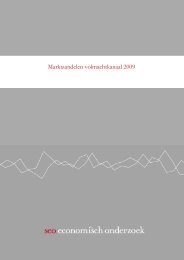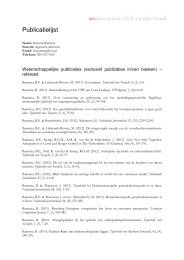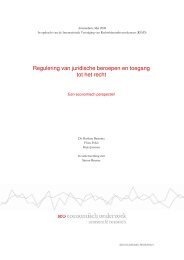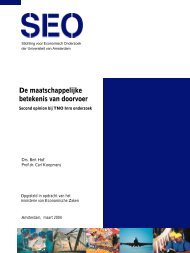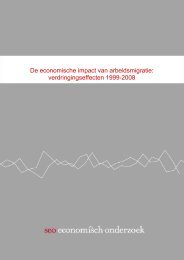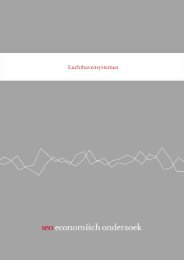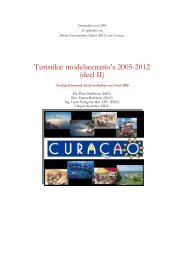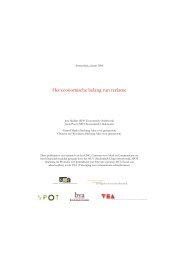Amsterdam, Netherlands - SEO Economisch Onderzoek
Amsterdam, Netherlands - SEO Economisch Onderzoek
Amsterdam, Netherlands - SEO Economisch Onderzoek
You also want an ePaper? Increase the reach of your titles
YUMPU automatically turns print PDFs into web optimized ePapers that Google loves.
6.1 Introduction6 CAPACITY BUILDING FOR REGIONAL COOPERATIONThis chapter discusses the regional engagement of HEIs and the networks that bond HEIs andother regional stakeholders together. Key issues that will be discussed in this chapter are:• Formal and informal mechanisms that exist at HEIs to identify and act on regional needs;• Communication and dialogue between HEIs and regional stakeholders;• The impact of HEIs on the regional labor market;• The lack of specific regional targets in HEIs’ strategic decision making;• Conflicts between HEIs’ international ambitions and regional engagement.Section 6.2 described the origin and governance of the HEIs participating in this review. Section6.3 then focuses on the (regional) mechanisms in the <strong>Amsterdam</strong> metropolitan region thatstimulate regional engagement of HEIs. Section 6.4 describes the mechanisms that promotecommunication and dialogue between HEIs and regional stakeholders. Section 6.4 discusses towhat extent HEIs in the metropolitan region have collectively and/or individually undertaken anaudit of their impacts on and links with the region. Section 6.6 describes the process ofinstitutional capacity building for regional involvement for each HEI separately. Finally section6.7 discusses to what extent HEIs’ organizational culture is directed towards regionalengagement.6.2 Origin and governance of the HEIs in the <strong>Amsterdam</strong> metropolitan areaHistoryThe origin of the VU University reflects the principle of freedom of educational choice in the<strong>Netherlands</strong>, which is anchored in Dutch constitutional law. Abraham Kuyper, Prime Minister ofthe <strong>Netherlands</strong> from 1901 to 1905, founded VU University <strong>Amsterdam</strong> in 1880. At first theuniversity was only open to Reformed Christians and was entirely financed by their fund-raisingefforts and donations. Since the 1960s, however, VU University <strong>Amsterdam</strong> has been open toeveryone and funded in the same way as the other Dutch universities, although it still retains itstradition of Christian standards and values.The historical development of the UvA reflects the involvement of the local community inbuilding a regional infrastructure for higher education. The predecessor of the UvA, theAthenaeum Illustre, was founded in <strong>Amsterdam</strong> in 1632 to educate students in Trade andPhilosophy. Lessons were generally given at the professors’ homes, as the establishment was notyet a proper university. The Athenaeum remained a small institution until the nineteenth century,with no more than 250 students and eight teachers. The situation changed in 1877 when theAthenaeum Illustre became the (City) University of <strong>Amsterdam</strong> (UvA). The involvement of thecity with the university ended in 1961when the UvA became a nationally governed university likeall other universities in the <strong>Netherlands</strong>.The historical roots of the HVA go back to the schools for professional education in <strong>Amsterdam</strong>such as the Kweekschool voor machinisten founded in 1878. Prior to 1955 these schools were notconsidered as part of the system of higher education (Van Bemmel 2006, p. 4). A government billfrom this year first listed the universities of applied science as a form of higher education. Since1963 they are part of the system of publicly funded higher eduction in the <strong>Netherlands</strong>. Latergovernmental policies supported the collaboration and integration of the separate UASs which ledto the emergence of large educational institutes like HVA. Since the merger of 2004 HVA andUVA fall under the control of a joint executive board.117



